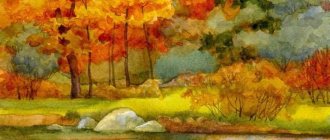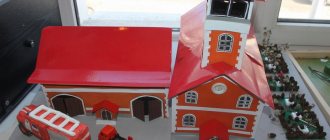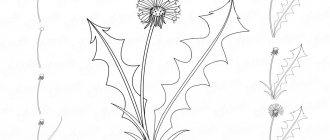- October 4, 2019
- Leisure
- Yulia Tershak
The theme of kindergarten is one of the most popular among parents of young children. Is it worth sending your child to kindergarten? When? How can I help him adapt quickly to kindergarten? How to love your teacher and other children? What feelings does a child experience in kindergarten? To find the right answers to these questions, you can use art diagnostics or art therapy.
When preparing your child for going to kindergarten, you can use a drawing. Getting to know the kindergarten in the form of drawing will interest and captivate the child, making him want to visit this institution with other children. To find out if your child is doing well in kindergarten, you can also invite him to draw the teacher and the children.
You can learn how to draw a kindergarten from this article.
Drawing a kindergarten
First, the child needs to be told what a kindergarten is, what it looks like, who works there, who attends it, what the children do in class. To make the drawing of the kindergarten room beautiful, you need to use a pencil and a ruler. In the picture above you can see how to draw a kindergarten step by step.
We draw a few straight lines - and the frame of the room is ready. Walls, roof, doors, windows can already be painted in bright colors. Next, we draw a path to the garden; it should be cheerful and enticing. Near it you can finish drawing trees, flowers, bushes.
One of the main activities in kindergarten is walking children with teachers. We definitely draw a play area for walking. Near the kindergarten you need to place beautiful benches, pavilions, and a playground. All this will cause positive emotions in the child, and he will happily run to kindergarten.
Summary of drawing lesson “Our favorite kindergarten”
Integration of educational areas:
“Cognition” (formation of a holistic picture of the world), “Artistic and aesthetic development” (drawing, music, reading fiction), “Social and communicative development.”
Types of children's activities:
gaming, productive, communicative, cognitive-research, perception of fiction.
Goals:
develop independence and creativity, learn to reflect impressions of the life around you; to form ideas about kindergarten employees, about the work processes performed by each of them; cultivate respect for the work of adults; improve the ability to navigate the premises of a kindergarten.
Materials and equipment:
pictures depicting a janitor, cook, nanny, laundress, musician and representatives of other professions in kindergarten; subject pictures depicting objects needed by people of these professions; colored pencils, sheets of paper.
Progress of the lesson
1. Organizational moment.
Educator
. Guys, let's take a tour of our kindergarten. You will learn a lot of new and interesting things, and visit those corners of the building that you have never seen before. You will understand that
Our kindergarten, like other buildings, is an important part of the big city.
2. Tour of the kindergarten. Conversation.
The teacher shows all the groups and classrooms, the kitchen, laundry room, music and sports halls, the Russian Izba museum and other interesting rooms.
Educator
. People from different professions work in the kindergarten:
teacher, psychologist, nurse, physical education teacher, music director, cook, manager. There is also a nanny, a laundress, a janitor, and a watchman. What kind of work do they do? (The teacher names a profession, and the children say what kind of work a person does in this profession. For example, a nanny - cleans in a group, sets the table; a laundress - does laundry, etc.)
Why do you think a kindergarten needs a nurse?
And the cook? And the janitor? All employees are needed. Their work is important. We must respect their work and help them. How can we help the janitor? (Do not leave garbage on the street.)
What about the laundress and nanny?
(Do not stain the bed linen; set the table.)
3. Game “Whose objects?”
Educator
.
What items are in this or that room of the kindergarten? ( The teacher shows pictures showing dumbbells, balls, a piano, a Russian stove, a washing machine, a hob. Children try to give the correct answers.)
4. Physical education minute.
On the window in pots
Flowers rose
Reached for the sun
They smiled at the sun.
5. Reading a poem.
Educator.
I suggest you listen to a poem about the garden:
Children live in kindergartens, you love him, children,
They play and sing here, The kindest house in the world!
Here they find friends, G. Shalaeva.
They go for walks with them.
Kindergarten is your second home.
The teacher asks the children to tell what the kindergarten is like. Story outline:
- What is the name of our kindergarten?
- How many floors does it have?
- What is the name of the group?
- What floor is it on?
- What facilities does the group have?
5. Listening to a song.
“Our favorite kindergarten” (performer/author G. Azamatova).
6. Drawing.
Educator
. What's your mood now? Good? Then in
In a good mood, draw a picture with colored pencils on the theme “Our favorite kindergarten.” To do this, we will divide into three subgroups: the first subgroup will draw the building of our kindergarten covered with snow, surrounded by trees; the second one will draw a gym and all the corresponding attributes: stairs, balls, trampoline, treadmills; the third is to depict our museum “Russian Izba”; try to convey the main features of a Russian house such as wooden walls, a cradle, folk musical instruments, a Russian stove, and nesting dolls. Children diligently draw on given topics. The teacher helps the children, teaches them how to hold a pencil correctly, how to shade in one direction, and advises using more colors to make the drawing more saturated.
6. Conclusion.
Educator.
Well done boys! It was a great drawing, everyone tried very hard. Now let's look at all the drawings and try to evaluate them, determine which of you managed to most accurately depict our kindergarten. Children discuss the drawings and try to objectively evaluate their creativity. The teacher and the children organize an exhibition of drawings at the kindergarten stand.
Drawing children
Many children attend the kindergarten, among them there are both boys and girls. We draw a lot of different children, thin and plump, small and big, cheerful and not very cheerful. This will help the child quickly make friends with other children, find common interests and joint activities.
Don’t forget to also draw your own child among the children. This will be a kind of rehearsal, preparing the child for being in a children's group.
In the picture above you can see how to draw children step by step. When drawing a girl, we dress her in a beautiful dress, bright tights, and put on shoes. Don't forget about bows and hairstyle. We dress the boy in shorts and a T-shirt, with socks and shoes on his feet. Drawing children of different sexes contributes to the development of the child; he learns to look for differences between girls and boys, men and women.
On the topic: methodological developments, presentations and notes
collective work of children of group No. 91 of senior preschool age “Our favorite snowman Tosha.”
Summary of an open physical education lesson for the senior preschool group of a kindergarten on the topic: “Birds.”
Goal: to introduce children to the rules for pedestrians and passengers. Objectives: 1. Reinforce with children the concepts of “driver” and “pedestrian.”2. Develop children's horizons and logical thinking.
Musical lounge for May 9 “With a song until Victory.” Notes with a presentation for children of the senior preparatory group of kindergarten.
Formation of moral and patriotic feelings in children through systematization of knowledge about the Constitution of the Russian Federation.
Many safety rules arose in ancient times, when people tried to protect themselves from wild animals and natural phenomena. Over time, human living conditions have changed and become different.
A lesson to familiarize children with the work of kindergarten staff.
Source
Drawing a teacher
The main adult responsible for the safety and comfort of the child is the teacher. She should be drawn as beautiful and cheerful, so that the child would want to get to know her and make friends. The face should look pleasant and smiling. The child needs to be explained that the teacher should be contacted with any problems or misunderstandings, that she is kind and sympathetic and will always help solve any situation. In addition, she feeds the children lunch and puts them to bed. You can draw children while eating or sleeping in their cribs. The child will be interested to know what the sleeping area looks like in kindergarten, how and what children eat.
Preview:
SUMMARY OF NODES IN A MIDDLE GROUP ON DRAWING ON THE TOPIC
"OUR FAVORITE KINDERGARTEN."
Integration of educational areas: “Cognition” (formation of a holistic picture of the world), “Artistic and aesthetic development” (drawing, music, reading fiction), “Social and communicative development.”
Types of children's activities: playful, productive, communicative, cognitive-research, perception of fiction.
Goals: develop independence and creativity, learn to reflect impressions of the life around you; form ideas about kindergarten employees, about the work processes performed by each of them; cultivate respect for the work of adults; improve the ability to navigate the premises of a kindergarten.
Materials and equipment: pictures depicting a janitor, cook, nanny, laundress, musician and representatives of other professions in kindergarten; subject pictures depicting objects needed by people of these professions; colored pencils, sheets of paper.
1. Organizational moment.
Educator. Guys, let's take a tour of our kindergarten. You will learn a lot of new and interesting things, and visit those corners of the building that you have never seen before. You will understand that
Our kindergarten, like other buildings, is an important part of the big city.
2. Tour of the kindergarten. Conversation.
The teacher shows all the groups and classrooms, the kitchen, laundry room, music and sports halls, the Russian Izba museum and other interesting rooms.
Educator. People from different professions work in the kindergarten:
teacher, psychologist, nurse, physical education teacher, music director, cook, manager. There is also a nanny, a laundress, a janitor, and a watchman. What kind of work do they do? (The teacher names a profession, and the children say what kind of work a person does in this profession. For example, a nanny - cleans in a group, sets the table; a laundress - does laundry, etc.) Why do you think a nurse is needed in a kindergarten? And the cook? And the janitor? All employees are needed. Their work is important. We must respect their work and help them. How can we help the janitor? (Do not leave garbage on the street.) What about the laundress and nanny? (Do not stain the bed linen; set the table.)
3. Game “Whose objects?”
Educator. What items are in this or that room of the kindergarten? (The teacher shows pictures showing dumbbells, balls, a piano, a Russian stove, a washing machine, a stove. Children try to give the correct answers.)
On the window in pots
Reached for the sun
5. Reading a poem.
Educator. I suggest you listen to a poem about the garden:
Children live in kindergartens, you love him, children,
Entertainment in kindergarten
The child already knows how to draw a kindergarten, children, teachers, now he should move on to the entertainment that awaits him there.
We give each child a toy. We draw children playing with cars, children's dishes, dolls, balls, books. We invite the child to dream up what other toys there might be in kindergarten, and to finish drawing them himself.
It is important to depict music, dance, physical exercise, and outdoor games in the picture. This will help the child fall in love with kindergarten and enjoy attending it. If parents know how to draw a kindergarten to intrigue their child, then adaptation will be easy and unnoticeable. Preparing to attend kindergarten is an important point in order to avoid psychological trauma from parting with loved ones.
On the topic: methodological developments, presentations and notes
Objectives of the lesson: learn to draw a bear along the contour with a poke; instill interest in drawing and foster cognitive activity. Learn to find similarities with a toy and enjoy the result.
Non-traditional techniques: colored scratch paper, wax crayons + watercolor, watercolor crayons. Purpose: to form an aesthetic attitude towards fairy-tale characters; learn to display the features of images in a drawing.
GCD for drawing in the second junior group based on the nursery rhyme “Cucumber, Cucumber.” GCD in the middle drawing group based on the nursery rhyme “Magpie, Magpie” Plan – summary of the GCD in the senior drawing group on the so-called.
Summary of a lesson in a senior group on drawing on the topic: “Spring drops.”
Compiled by: teacher 1st quarter. Denisova I.S. .
Lesson notes on artistic development.
Goal: teach children to draw a church with colored pencils.
Source






